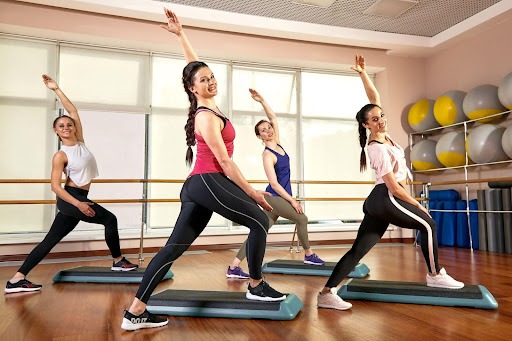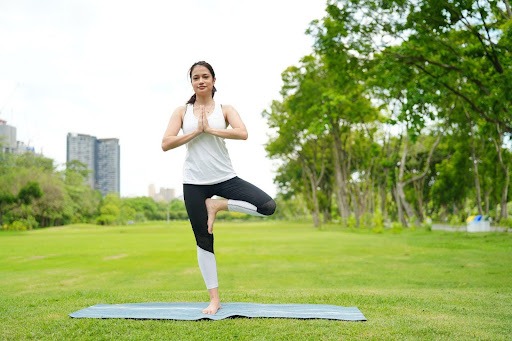The Ultimate Guide to Exercise During Menopause
Menopause Exercise: Tips for Staying Active and Healthy
Menopause is a significant phase in a woman’s life, marked by the end of menstruation and reproductive years. It brings about various physiological changes due to the fluctuation and eventual decline in hormone levels. These changes can lead to symptoms such as hot flashes, mood swings, weight gain, and bone density loss. Regular exercise is a powerful tool to manage these symptoms and improve overall well-being. This comprehensive guide will explore the best exercises for women during menopause, ensuring a healthier and more comfortable transition.
Benefits Of Exercise During Menopause
Regular physical activity offers numerous benefits during menopause, including:

- Weight Management: Exercise helps in maintaining a healthy weight, which is often a challenge during menopause due to hormonal changes.
- Bone Health: Weight-bearing exercises strengthen bones and reduce the risk of osteoporosis.
- Cardiovascular Health: Aerobic exercises improve heart health and reduce the risk of cardiovascular diseases.
- Mental Health: Physical activity boosts mood, reduces stress, and helps manage anxiety and depression.
- Sleep Quality: Regular exercise can improve sleep patterns, which are often disrupted during menopause.
Menopause Exercise Plan
1. Aerobic Exercise
Aerobic exercise, also known as cardiovascular exercise, is essential for maintaining heart health and managing weight. It includes activities that increase your heart rate and breathing.

- Walking: A simple, low-impact exercise that can be done anywhere. Aim for at least 30 minutes of brisk walking most days of the week.
- Jogging or Running: For those who are more fit, jogging or running can provide more intense cardiovascular benefits.
- Swimming: A full-body workout that is easy on the joints, making it ideal for women experiencing joint pain.
- Cycling: Both outdoor and stationary cycling are excellent ways to improve cardiovascular health.
2. Strength Training
Strength training is crucial for maintaining muscle mass and bone density, which can decline during menopause. It involves exercises that use resistance to build muscle strength.

- Weight Lifting: Using free weights or weight machines to target different muscle groups. Focus on exercises like squats, lunges, and bench presses.
- Bodyweight Exercises: Push-ups, pull-ups, and planks are effective strength training exercises that do not require equipment.
- Resistance Bands: These are portable and versatile tools that can be used to perform various strength training exercises.
3. Flexibility and Balance Exercises
Maintaining flexibility and balance is important to prevent falls and injuries, which can be a concern as we age.

- Yoga: Promotes flexibility, balance, and relaxation. Poses like the tree pose and warrior pose are particularly beneficial.
- Pilates: Focuses on core strength, flexibility, and balance. It can be adapted to various fitness levels.
- Tai Chi: A gentle form of martial arts that enhances balance, flexibility, and mental relaxation.
4. High-Intensity Interval Training (HIIT)
HIIT involves short bursts of intense exercise followed by periods of rest or low-intensity exercise. It can be very effective for improving cardiovascular fitness and burning calories in a shorter amount of time.

- Sprint Intervals: Short bursts of running or cycling at maximum effort followed by a slower pace to recover.
- Circuit Training: Combining different exercises like squats, push-ups, and jumping jacks in a sequence with minimal rest in between.
Creating an Exercise Routine For Menopause Exercise
Assess Your Fitness Level
Before starting any exercise program, it’s important to assess your current fitness level. Consult with a healthcare provider or a fitness professional to determine a safe and effective exercise plan tailored to your needs.
Set Realistic Goals
Set achievable goals based on your fitness level and lifestyle. Whether it’s improving cardiovascular health, building muscle strength, or enhancing flexibility, having clear goals can keep you motivated.
Mix It Up
Variety is key to staying motivated and preventing boredom. Incorporate different types of exercises into your routine to target various aspects of fitness and keep your workouts interesting.
Listen to Your Body
Pay attention to how your body responds to different exercises. It’s normal to feel some discomfort when starting a new exercise routine, but sharp pain or persistent soreness should not be ignored. Adjust the intensity and type of exercise as needed to avoid injury.
Stay Consistent
Consistency is crucial for reaping the benefits of exercise. Aim for at least 150 minutes of moderate-intensity aerobic activity or 75 minutes of vigorous-intensity activity per week, combined with muscle-strengthening activities on two or more days a week.
Additional Tips for Exercising During Menopause
Alongside the recommended exercises and nutritional advice, here are some additional tips to optimize your workout experience and maximize the benefits:
- Stay Hydrated: Drink plenty of water before, during, and after exercise to stay hydrated.
- Warm-Up and Cool-Down: Always start with a warm-up to prepare your muscles and end with a cool-down to help your body recover.
- Wear Appropriate Clothing: Choose comfortable, breathable clothing and supportive footwear to enhance your workout experience.
- Monitor Your Heart Rate: Use a heart rate monitor to ensure you are working out at the right intensity level.
- Stay Social: Exercise with friends or join a fitness class to stay motivated and make workouts more enjoyable.
Overcoming Common Exercise Barriers During Menopause
While the benefits of exercise during menopause are well-documented, many women face barriers that make it challenging to maintain a consistent routine. Understanding these barriers and finding practical solutions can help ensure that exercise remains a priority.
1. Lack of Time
Barrier: Busy schedules can make it difficult to find time for regular exercise.
Solution: Incorporate short, high-intensity workouts like HIIT into your routine, which can be as effective as longer sessions. Even 10-15 minutes of activity can be beneficial. Consider breaking your exercise into smaller chunks throughout the day, such as taking a brisk walk during lunch breaks or doing strength training exercises while watching TV.
2. Fatigue and Low Energy Levels
Barrier: Menopausal symptoms such as hot flashes and night sweats can lead to poor sleep and fatigue, reducing energy levels for exercise.
Solution: Prioritize sleep hygiene by maintaining a regular sleep schedule, creating a comfortable sleep environment, and avoiding caffeine and electronics before bedtime. Start with low-impact exercises like walking or yoga, which can boost energy levels without overwhelming your body. Gradually increase the intensity as your energy improves.
3. Joint Pain and Stiffness
Barrier: Hormonal changes during menopause can cause joint pain and stiffness, making exercise uncomfortable.
Solution: Opt for low-impact exercises such as swimming, cycling, or using an elliptical machine, which are easier on the joints. Incorporate flexibility and stretching exercises like yoga and Pilates to improve joint mobility and reduce stiffness. Always warm up before exercising and cool down afterward to prevent injury.
4. Lack of Motivation
Barrier: Menopause can affect mood and motivation, making it harder to stick to an exercise routine.
Solution: Set specific, achievable goals and track your progress to stay motivated. Find an exercise buddy or join a fitness class to add a social element to your workouts. Reward yourself for meeting milestones, whether it’s with a new workout outfit or a relaxing spa day.
Nutrition and Hydration To Supporting Your Exercise Routine
Proper nutrition and hydration play a crucial role in supporting an active lifestyle during menopause. Here are some dietary tips to complement your exercise regimen:

1. Balanced Diet
Consume a balanced diet rich in whole foods, including:
- Fruits and Vegetables: Provide essential vitamins, minerals, and antioxidants.
- Lean Proteins: Support muscle repair and growth. Include sources like chicken, fish, beans, and tofu.
- Whole Grains: Offer sustained energy and fiber. Opt for whole wheat, oats, quinoa, and brown rice.
- Healthy Fats: Support hormonal balance and overall health. Include avocados, nuts, seeds, and olive oil.
2. Calcium and Vitamin D
Calcium and vitamin D are essential for bone health, especially during menopause when the risk of osteoporosis increases. Include calcium-rich foods like dairy products, leafy greens, and fortified plant milks. Get adequate sunlight exposure and consider supplements if necessary to ensure sufficient vitamin D levels.
3. Hydration
Staying hydrated is vital, particularly when exercising. Menopausal women should aim to drink plenty of water throughout the day. Herbal teas and electrolyte-infused beverages can also help maintain hydration levels.
Mind-Body Connection For Enhancing Mental and Emotional Well-being
Menopause is not only a physical transition but also a time of significant emotional and mental change. Integrating mind-body practices into your exercise routine can enhance overall well-being.

1. Meditation and Mindfulness
Practices such as meditation and mindfulness can help manage stress and improve mental clarity. Consider incorporating mindfulness meditation or guided relaxation into your daily routine. Apps and online resources can provide structured programs for beginners.
2. Breathing Exercises
Deep breathing exercises can reduce anxiety, improve focus, and enhance relaxation. Techniques like diaphragmatic breathing or the 4-7-8 breathing method can be practiced anywhere and are especially helpful during moments of stress or hot flashes.
3. Journaling
Keeping a journal can provide a constructive outlet for emotions and track your menopause journey. Reflect on your exercise progress, dietary habits, and overall mood to identify patterns and areas for improvement.
Join the Miror Community
The journey through perimenopause and menopause can be challenging, but you don’t have to do it alone. Join the Miror Community to be part of a supportive group of women and experts dedicated to helping you ease through this transition. As a member, you’ll gain access to exclusive sessions and events designed to address your unique needs and concerns.
https://chat.whatsapp.com/G7JKOO6BhygDv5w6vFnp8O
Final Takeaway
Exercise is a powerful tool for managing menopause symptoms and improving overall health. By incorporating a variety of aerobic, strength, flexibility, and balance exercises, women can navigate this transition with greater ease and confidence. Overcoming common barriers, maintaining proper nutrition and hydration, focusing on the mind-body connection, and building a supportive network are all essential components of a successful exercise routine during menopause. Stay committed, listen to your body, and embrace this new chapter with a proactive approach to health and wellness.





